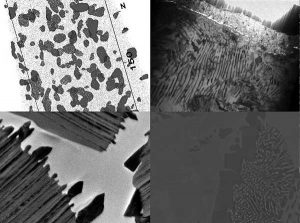With his plans to develop an open-source manufacturing platform, Peter Collins is determined to make additive manufacturing a mainstream technology.
Collins, who is an associate professor in materials science and engineering, says the advantages of additive manufacturing—using fewer resources, improving material performance and creating one-of-a-kind products—can be a game changer for manufacturers of all sizes.
 That’s why he’s working on a program that will reduce the amount of testing involved with the additive manufacturing process.
That’s why he’s working on a program that will reduce the amount of testing involved with the additive manufacturing process.
“When we look at creating a better material, additive manufacturing is a great place to start,” he explains. “Rather than taking a huge piece of material and sizing it down to fit within the parameters we have, researchers add small amounts of powder to specific areas of a material to achieve desired characteristics and geometries. It’s simply a more efficient and effective approach.”
Collins wants to tailor materials to exact specifications, such as designing high strength on one side of the material and high stiffness on the opposite side. He says being able to change composition of a material is useful for many industries, including energy, aerospace and automobile markets.
But testing materials created through additive manufacturing is a significant investment and a big part of why the process isn’t commercially available. “Manufacturers spend sizable amounts of money to create a large piece of material, then section it into smaller pieces to send off for mechanical, fatigue and composition tests,” Collins says. “As you can imagine, it’s expensive, and if something doesn’t meet the desired performance, you have to create a new piece of material and do it all over again.”
Material characterization, which involves looking at how the atoms and crystals in the material are arranged, can help researchers predict the composition of a material and reduce the expenses associated with testing. “Knowing how materials will respond after they go through specific processes will help us understand what elements we will lose and what characteristics the material we’ve developed will exhibit.”
A large part of his research with groups such as the Defense Advanced Research Projects Agency, National Science Foundation and the Boeing Company focuses on bringing this materials science mindset into additive manufacturing.
He also wants to reduce costs associated with additive manufacturing, which accumulate thanks to the equipment, like lasers and electron beams, used in the process. So he’s developing an open-source manufacturing platform with visions that every town could implement additive manufacturing. “Something like this would mean a farmer could go into town and repair or create a new piece of equipment instead of paying an exorbitant amount to have one made and shipped to them,” he explains.
While he knows there’s a lot of research that needs to be done before this vision becomes reality, he says his approach is definitely a step in the right direction.
“Adding material characterization to the process gives us the information necessary for exploring and creating superior materials for the manufacturing industry much quicker than has been done in the past.”